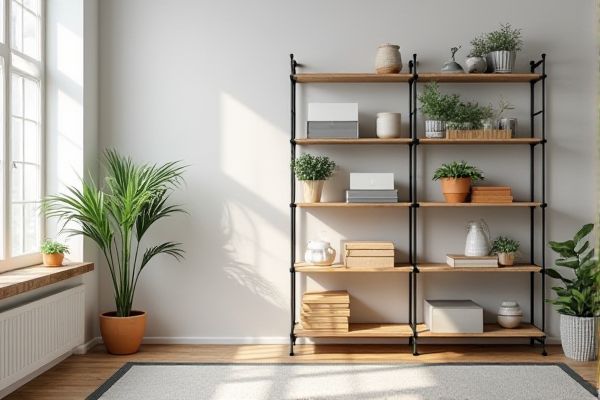
Wire racks offer superior airflow and durability, making them ideal for storing items that require ventilation and easy cleaning. Wooden shelves provide a warmer aesthetic and sturdy support for heavier objects; explore the full comparison to determine which best fits your storage needs.
Table of Comparison
| Feature | Wire Rack | Wooden Shelf |
|---|---|---|
| Material | Metal wires (usually steel or chrome-plated) | Wood (solid or engineered) |
| Weight Capacity | High; supports heavy items effectively | Moderate; depends on wood type and thickness |
| Durability | Rust-resistant (if coated), long-lasting | Prone to warping and moisture damage without treatment |
| Air Circulation | Excellent; open wire design | Poor; solid surface limits airflow |
| Maintenance | Easy to clean; wipe or spray down | Requires occasional polishing or sealing |
| Appearance | Industrial, utilitarian look | Warm, natural aesthetic |
| Cost | Generally affordable | Varies; often higher depending on wood type |
| Best Use | Garage, pantry, commercial storage | Living spaces, decorative storage |
Introduction to Wire Racks and Wooden Shelves
Wire racks are lightweight, durable storage solutions made from metal, offering excellent ventilation and easy visibility for your items. Wooden shelves provide a sturdy and classic aesthetic, with the ability to support heavier loads and add warmth to any space. Choosing between them depends on your specific storage needs, desired style, and the environment where they will be used.
Material Composition: Metal vs. Wood
Wire racks are constructed from metal, typically stainless steel or chrome-plated steel, offering durability, corrosion resistance, and a lightweight structure ideal for heavy-duty storage. Wooden shelves consist of natural or engineered wood, providing a warmer aesthetic and sturdiness but may require more maintenance to prevent warping or moisture damage. Your choice between a wire rack and wooden shelf depends on the desired balance between industrial strength and rustic appeal.
Durability and Longevity Comparison
Wire racks offer superior durability and resistance to moisture, making them ideal for environments prone to humidity or spills, while wooden shelves provide a classic aesthetic but may degrade faster due to susceptibility to warping and rot. Metal wire racks typically withstand heavier loads and require less maintenance over time, ensuring longevity in both residential and commercial settings. Your choice depends on whether you prioritize resilience and low upkeep or a traditional look with potential need for replacement or repair.
Aesthetic Appeal and Design Flexibility
Wire racks offer a modern, industrial aesthetic with sleek lines and open designs that enhance visibility and airflow, making them ideal for contemporary spaces. Wooden shelves provide warm, natural textures and can be crafted in various styles from rustic to elegant, offering greater customization in color and finish. Design flexibility is heightened with wooden shelves due to their ease of modification and ability to blend seamlessly into different interior themes, while wire racks excel in modularity and lightweight structures.
Weight Capacity and Strength Analysis
Wire racks typically offer higher weight capacity and superior strength due to their metal construction, supporting loads up to 800 lbs per shelf, making them ideal for heavy storage needs. Wooden shelves, while aesthetically pleasing, generally support lower weight, often around 200-400 lbs per shelf depending on wood type and thickness, and may deform or sag under excessive load. For industrial or heavy-duty use, wire racks provide more reliable durability and load-bearing performance compared to wooden shelves.
Installation and Assembly Process
Wire racks feature a straightforward installation and assembly process, often requiring minimal tools and snapping components into place, making them ideal for quick setups. Wooden shelves typically demand more time and skill, involving measurements, drilling, and securing brackets to ensure stability. Both options provide customization, but wire racks excel in ease and speed of assembly compared to the more involved process of wooden shelving.
Maintenance and Cleaning Requirements
Wire racks require minimal maintenance due to their open structure, which allows for easy cleaning and quick drying, reducing the risk of rust with regular wiping and occasional application of rust-resistant spray. Wooden shelves demand more care, needing periodic dusting, polishing, and protection from moisture to prevent warping, staining, or mold growth. Wire racks are more resistant to heavy cleaning chemicals, whereas wooden shelves may deteriorate if exposed to harsh cleaners frequently.
Cost Considerations and Value
Wire racks generally offer a lower upfront cost compared to wooden shelves, making them a budget-friendly option for storage solutions. Wooden shelves provide greater long-term value due to their durability and aesthetic appeal, which can enhance the overall space and require less frequent replacement. Choosing between the two depends on balancing initial expense against longevity and desired appearance.
Ideal Use Cases and Applications
Wire racks excel in commercial kitchens, garages, and warehouses where ventilation, moisture resistance, and easy cleaning are crucial for food storage, tools, or inventory management. Wooden shelves are ideal for living spaces or retail environments that prioritize aesthetic appeal, supporting heavier items like books or decor with a sturdy, natural finish. Your choice depends on balancing functional needs such as durability and airflow versus warmth and design.
Sustainability and Environmental Impact
Wire racks are often made from recyclable steel, offering durability and reduced environmental waste compared to wooden shelves, which typically rely on timber that may contribute to deforestation if not sourced sustainably. Wooden shelves, particularly those crafted from reclaimed or responsibly managed forests, can provide a renewable option with lower carbon emissions during production but may lack the recyclability of metal. Both materials' environmental impact depends largely on sourcing, manufacturing processes, and end-of-life recyclability, making sustainable certification and lifecycle assessment critical factors in choosing eco-friendly storage solutions.
 homyna.com
homyna.com